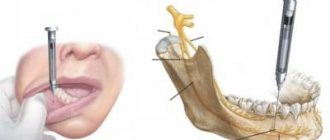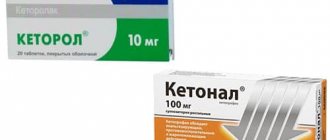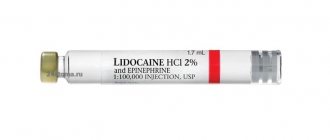Lidocaine
The toxicity of lidocaine increases when it is used simultaneously with cimetidine and propranolol due to an increase in the concentration of lidocaine; this requires a reduction in the dose of lidocaine. Both drugs reduce hepatic blood flow. In addition, cimetidine inhibits the microsomal activity of liver enzymes.
Ranitidine, Diltiazem, verapamil, propranolol and other β-blockers reduce the clearance of lidocaine, which leads to an increase in its concentration in the blood plasma.
Antiviral agents (eg, amprenavir, atazanavir, darunavir, lopinavir) can also cause increased serum concentrations of lidocaine.
Hypokalemia caused by diuretics may reduce the effect of lidocaine when used simultaneously (see section "Special Instructions"). Lidocaine should be used with caution in patients receiving other local anesthetics or agents structurally similar to amide-type local anesthetics (eg, antiarrhythmic agents such as mexiletine, tocainide) because systemic toxic effects are additive.
When lidocaine is used in combination with narcotic analgesics, hexenal or sodium thiopental, the inhibitory effect on the central nervous system and respiration may be enhanced.
Separate drug interaction studies have not been conducted between lidocaine and class III antiarrhythmic drugs (eg, amiodarone), but caution is recommended when using them together.
In patients concomitantly receiving antipsychotics that prolong or have the potential to prolong the QT interval (e.g., pimozide, sertindole, olanzapine, quetiapine, zotepine), prenylamine, epinephrine (with occasional intravenous administration), or 5-HT3-serotonin receptor antagonists (e.g., tropisetron, dolasetron), the risk of developing ventricular arrhythmias may increase.
Concomitant use of quinupristin/dalfopristin may increase lidocaine concentrations and thus increase the risk of developing ventricular arrhythmias; their simultaneous use should be avoided.
Patients receiving muscle relaxants (eg, suxamethonium) may have an increased risk of enhanced and prolonged neuromuscular blockade.
Cardiovascular insufficiency has been reported following the use of bupivacaine in patients receiving verapamil and timolol; lidocaine is similar in structure to bupivacaine.
Dopamine and 5-hydroxytryptamine lower the seizure threshold in patients receiving lidocaine.
Opioids appear to have anticonvulsant effects, supported by evidence that lidocaine lowers the seizure threshold to fentanyl in humans.
Combinations of opioids and antiemetics, sometimes used for sedation in children, may lower the seizure threshold to lidocaine and increase its CNS depressant effects.
The use of epinephrine with lidocaine may reduce systemic absorption, but with accidental intravenous administration the risk of ventricular tachycardia and ventricular fibrillation increases sharply.
Concomitant use of other antiarrhythmic drugs, beta-blockers and slow calcium channel blockers may further reduce AV conduction, ventricular conduction and myocardial contractility.
The simultaneous use of vasoconstrictors increases the duration of action of lidocaine.
Concomitant use of lidocaine and ergot alkaloids (eg, ergotamine) can cause severe hypotension.
Caution must be exercised when using sedatives as they may interfere with the action of local anesthetics on the central nervous system. Caution should be exercised when using antiepileptic drugs (phenytoin), barbiturates and other inhibitors of liver microsomal enzymes, as this may lead to decreased effectiveness and, as a result, an increased need for lidocaine. On the other hand, intravenous administration of phenytoin may enhance the depressant effect of lidocaine on the heart.
The analgesic effect of local anesthetics can be enhanced by opioids and clonidine.
The combined use of lidocaine with procainamide can cause central nervous system stimulation and hallucinations.
When using lidocaine and polymyxin-B simultaneously, it is necessary to monitor the patient's respiratory function. Ethyl alcohol, especially with prolonged abuse, can reduce the effect of local anesthetics. Lidocaine is not compatible with amphotericin B, methohexitone, nitroglycerin.
With the simultaneous use of lidocaine with narcotic analgesics, an additive effect develops, which is used during epidural anesthesia, but increases the depression of the central nervous system and respiration.
Vasoconstrictors (epinephrine, methoxamine, phenylephrine) prolong the local anesthetic effect of lidocaine and can cause increased blood pressure and tachycardia.
Use with monoamine oxidase inhibitors (furazolidone, procarbazine, selegipine) probably enhances the local anesthetic effect of lidocaine and increases the risk of lowering blood pressure. Guanadrel, guanethidine, mecamylamine, grimstaphane camsylate increase the risk of a pronounced decrease in blood pressure and bradycardia. Anticoagulants (including ardeparin sodium, dalteparin sodium, danaparoid sodium, enoxaparin sodium, heparin, warfarin, etc.), nonsteroidal anti-inflammatory drugs (NSAIDs) or plasma expanders increase the risk of bleeding.
Lidocaine reduces the cardiotonic effect of digitoxin.
Lidocaine reduces the effect of antimyasthenic drugs (prozerin, oxazil, etc.), enhances and prolongs the effect of muscle relaxant drugs.
When treating the injection site with disinfectant solutions containing heavy metals, the risk of developing a local reaction in the form of pain and swelling increases.
Mixing lidocaine with other medications is not recommended.
Lidocaine
The toxicity of lidocaine increases when it is used simultaneously with cimetidine due to an increase in the concentration of lidocaine; this requires a reduction in the dose of lidocaine. Both drugs reduce hepatic blood flow. In addition, cimetidine inhibits microsomal activity. Ranitidine slightly reduces the clearance of lidocaine, which leads to an increase in its concentration. Antiviral agents (eg, amprenavir, atazanavir, darunavir, lopinavir) can also cause increased serum concentrations of lidocaine.
Hypokalemia caused by diuretics may reduce the effect of lidocaine when used simultaneously (see section "Special Instructions").
Lidocaine should be used with caution in patients receiving other local anesthetics or agents structurally similar to amide-type local anesthetics (eg, antiarrhythmic agents such as mexiletine, tocainide) because systemic toxic effects are additive.
Separate drug interaction studies have not been conducted between lidocaine and class III antiarrhythmic agents (eg, amiodarone), but caution is advised.
In patients concomitantly receiving antipsychotics that prolong or may prolong the OT interval (e.g. pimozide, sertindole, olanzapine, quetiapine, zotepine), prenylamine, epinephrine (with occasional intravenous administration) or 5-HT3-serotonin receptor antagonists (e.g. tropisetron, dolasetron ), the risk of developing ventricular arrhythmias may increase.
Concomitant use of quinupristin/dalfopristin may increase lidocaine concentrations and thus increase the risk of ventricular arrhythmias; their simultaneous use should be avoided.
Patients receiving concomitant muscle relaxants (eg, suxamethonium) may have an increased risk of enhanced and prolonged neuromuscular blockade.
Cardiovascular insufficiency has been reported following the use of bupivacaine in patients receiving verapamil and timolol; lidocaine is similar in structure to bupivacaine.
Dopamine and 5-hydroxytryptamine lower the seizure threshold to lidocaine. Opioids appear to have anticonvulsant effects, supported by evidence that lidocaine lowers the seizure threshold to fentanyl in humans. Combinations of opioids and antiemetics, sometimes used for sedation in children, may lower the seizure threshold to lidocaine and increase its CNS depressant effects.
The use of epinephrine with lidocaine may reduce systemic absorption, but with accidental intravenous administration the risk of ventricular tachycardia and ventricular fibrillation increases sharply.
The simultaneous use of other antiarrhythmics, β-blockers and blockers of “slow” calcium channels may further reduce AV conduction, ventricular conduction and contractility.
The simultaneous use of vasoconstrictors increases the duration of action of lidocaine.
Concomitant use of lidocaine and ergot alkaloids (eg, ergotamine) can cause severe hypotension.
Caution must be exercised when using sedatives as they may interfere with the action of local anesthetics on the central nervous system.
Caution should be exercised with long-term use of antiepileptic drugs (phenytoin), barbiturates and other inhibitors of liver microsomal enzymes, as this may lead to decreased effectiveness and, as a result, an increased need for lidocaine. On the other hand, intravenous administration of phenytoin may enhance the inhibitory effect of lidocaine on the heart.
The analgesic effect of local anesthetics can be enhanced by opioids and clonidine.
Ethyl alcohol, especially with prolonged abuse, can reduce the effect of local anesthetics.
Lidocaine is not compatible with amphotericin B, methohexitone and nitroglycerin.
With the simultaneous use of lidocaine with narcotic analgesics, an additive effect develops, which is used during epidural anesthesia, but increases the depression of the central nervous system and respiration. Vasoconstrictors (epinephrine, methoxamine, phenylephrine) prolong the local anesthetic effect of lidocaine and can cause increased blood pressure and tachycardia.
Use with monoamine oxidase inhibitors (furazolidone, procarbazine, seleginine) probably enhances the local anesthetic effect of lidocaine and increases the risk of lowering blood pressure.
Guanadrel, guanethidine, mecamylamine, trimethaphan camsylate increase the risk of a pronounced decrease in blood pressure and bradycardia.
Anticoagulants (including ardeparin sodium, dalteparin sodium, danaparoid sodium, enoxaparin sodium, heparin, warfarin, etc.) increase the risk of bleeding. Lidocaine reduces the cardiotonic effect of digitoxin.
Lidocaine reduces the effect of antimyasthenic drugs, enhances and prolongs the effect of muscle relaxants.
When treating the injection site with disinfectant solutions containing heavy metals, the risk of a local reaction in the form of painful swelling increases.
Mixing lidocaine with other medications is not recommended.
Is lidocaine dangerous during pregnancy?
According to the instructions for the drug, Lidocaine is contraindicated for use while waiting for the baby. However, cases where this drug was used for anesthesia in pregnant women are not so rare. Is the medication really suitable for use during pregnancy?
Lidocaine during early pregnancy
The first trimester of gestation (before the 12th week of pregnancy) is the most dangerous in terms of the use of any medications. The child’s body is just beginning to develop, so chemical compounds can cause irreparable harm to it. The most dangerous period is from 2 to 8 weeks of gestation, because the drug can have a teratogenic effect (provoke deformities, as well as dysfunction of organs and systems). Another danger lies in the threat of increased uterine tone. As a result, there is a threat of spontaneous pregnancy loss. Therefore, the use of lidocaine in the first trimester of pregnancy is strictly prohibited. The only exceptions may be urgent interventions.
Lidocaine during pregnancy in the second trimester
The second trimester of pregnancy is the safest for many interventions. Regarding the use of medications, restrictions on many of them are also becoming less stringent. This is due to the fact that the baby has already formed by this period, so negative effects on his body are practically excluded. Another factor is a decrease in the uterine sensitivity to external influences. The most common reason for using lidocaine during this period is the need for dental intervention. The severe pain that a pregnant woman may experience during treatment or tooth extraction can cause much more harm to the pregnancy than the anesthesia administered. During this period, it is also recommended to carry out other planned interventions, the duration of which does not allow the end of pregnancy.
Lidocaine during pregnancy in the third trimester
The final weeks of waiting for the baby again call into question the possibility of using Lidocaine. During this period, the woman’s body experiences maximum physiological stress. The result of using the drug may be premature onset of labor. At the same time, it is worth taking into account a possible reaction to the drug from the woman’s body - a drop in blood pressure and oxygen starvation of the expectant mother can lead to a slowdown in the baby’s heartbeat and asphyxia. The doctor must constantly monitor the woman’s condition and respond to the slightest changes. If the problem can be postponed for a while, it is better to return to it after the birth of the baby (especially if we are talking not about health, but about aesthetic beauty).
Lidocaine for toothache during pregnancy
Oral health is difficult to underestimate. The pain that occurs at the site of inflammation causes significant discomfort to the woman. No less dangerous is the infection that has accumulated in the affected area. In this case, you should under no circumstances hesitate to contact the dentist. Even if a woman does not experience acute pain, it is strongly recommended to visit a doctor if she has the following conditions:
- Periodically occurring or constant pain in the teeth (even of mild intensity).
- Bleeding gums.
- Increased sensitivity of teeth, manifested in pain when eating hot or cold food (or drinks).
A timely consultation with a dentist will help you adjust your oral care, thereby preventing the need for more radical intervention, incl. and with the use of anesthesia. During pregnancy the following treatment is allowed:
- Caries (resolution of hard dental tissues).
- Stomatitis (inflammation of the mucous tissue lining the oral cavity).
- Gingivitis (inflammation of the marginal surface of the gum).
- Pulpitis (inflammation of the internal tissues of the tooth).
Tooth extraction is allowed only if the latter are painful. An exception is wisdom teeth, because... their extraction is often accompanied by a complicated recovery period. So that tooth pain does not come as a shock and surprise to you, be sure to sanitize your oral cavity at the stage of pregnancy planning.
In dental practice, when treating pregnant patients, Lidocaine is used (if the doctor chose this drug) in the form of a spray (from 1 to 3 doses), as well as in the form of injections. It is worth considering that the area that needs to be numbed with the spray should be small, and the anesthesia time will last about 5 minutes. The medicine can be used no earlier than 16 weeks of gestation. The use of lidocaine during pregnancy for dental treatment in the form of “conduction” anesthesia is strictly not recommended. The dose of the drug is calculated based on the body weight of the pregnant woman. The maximum permissible dosage for an adult is 4.5 mg/kg.
Description of the drug LIDOCAINE HYDROCHLORIDE
When used simultaneously with barbiturates (including phenobarbital), it is possible to increase the metabolism of lidocaine in the liver, reduce the concentration in the blood plasma and, as a result, reduce its therapeutic effectiveness.
When used simultaneously with beta-blockers (including propranolol, nadolol), the effects of lidocaine (including toxic ones) may be enhanced, apparently due to a slowdown in its metabolism in the liver.
When used simultaneously with MAO inhibitors, the local anesthetic effect of lidocaine may be enhanced.
When used simultaneously with drugs that block neuromuscular transmission (including suxamethonium chloride), the effect of drugs that block neuromuscular transmission may be enhanced.
When used simultaneously with hypnotics and sedatives, the inhibitory effect on the central nervous system may be enhanced; with ajmaline, quinidine - possible increased cardiodepressive effect; with amiodarone - cases of seizures and SSSS have been described.
When used simultaneously with hexenal, sodium thiopental (iv), respiratory depression is possible.
When used simultaneously with mexiletine, the toxicity of lidocaine increases; with midazolam - a moderate decrease in the concentration of lidocaine in the blood plasma; with morphine - enhances the analgesic effect of morphine.
When used simultaneously with prenylamine, there is a risk of developing ventricular arrhythmias.
Cases of agitation and hallucinations have been described when used simultaneously with procainamide.
When used simultaneously with propafenone, the duration and severity of side effects from the central nervous system may increase.
It is believed that under the influence of rifampicin, a decrease in the concentration of lidocaine in the blood plasma is possible.
With simultaneous intravenous infusion of lidocaine and phenytoin, side effects of central origin may increase; a case of sinoatrial block due to the additive cardiodepressive effect of lidocaine and phenytoin is described.
In patients receiving phenytoin as an anticonvulsant, a decrease in the concentration of lidocaine in the blood plasma is possible, which is due to the induction of microsomal liver enzymes under the influence of phenytoin.
When used simultaneously with cimetidine, the clearance of lidocaine moderately decreases and its concentration in the blood plasma increases, and there is a risk of increased side effects of lidocaine.
special instructions
Lidocaine injection should only be done under the supervision of a physician. Treatment should be carried out under ECG control.
Before starting treatment, it is recommended to examine the level of potassium in the blood, since if its content is reduced, the effectiveness of the drug decreases.
The drug has an effect on the central nervous system, so it is not recommended to drive or engage in potentially life-threatening activities while using it.
Careful monitoring is required for patients prone to seizures, as even small doses may enhance the convulsive effect.
It is necessary to combine lidocaine with caution with those drugs that increase its bioavailability or slow down its elimination, which can be especially dangerous in case of end-stage renal failure.
With intramuscular administration of lidocaine solution, increased activity of creatine phosphokinase may be observed, which prevents the diagnosis of myocardial infarction.
Rapid administration of lidocaine solution can lead to a sharp decrease in blood pressure, with the possibility of collapse. In this case, the toxic effect of the drug with its cardiotoxic effect should also be considered.
Lidocaine (Lidocaine)
Clinical manifestations when used as a local anesthetic: apnea, collapse (decreased blood pressure, rare or arrhythmic pulse, pallor, sweating, possible cardiac arrest), methemoglobinemia (shortness of breath on exertion, dizziness, headache, weakness or fatigue), central neurotoxicity ( double vision, confusion, convulsions, dizziness, ringing or buzzing in the ears, trembling, irritability, agitation, nervousness; possible stimulation and then depression of the central nervous system, as well as loss of consciousness and respiratory arrest).
Clinical manifestations when used as an antiarrhythmic. When the concentration of lidocaine in the blood plasma is 6-8 mcg/ml: blurred vision or double vision, nausea or vomiting, ringing in the ears, tremors or muscle twitching, dizziness, euphoria, decreased blood pressure; when lidocaine concentration in blood plasma is more than 8 mcg/ml: difficulty breathing, severe dizziness or fainting, convulsions, bradycardia.
Treatment: in case of severe reactions, stop administering the drug, monitor vital signs, airway patency and oxygen supply; for collapse - infusion therapy and the use of vasopressors. In case of hypotension, the parturient woman must be placed on her left side to eliminate the pressure of the pregnant uterus on the aorta and inferior vena cava; delivery may improve response to interventions. In case of convulsions, ensure patient safety and oxygen supply; if there is no effect of respiratory support - intravenous administration of benzodiazepines (diazepam in increments of 2.5 mg) or ultra-short-acting barbiturates (sodium thiopental, thiamylal in increments of 50-100 mg; with intravenous administration of barbiturates, inhibition of hemocirculation is possible) with an interval of 2-3 minutes; for intractable convulsions and the presence of artificial ventilation, muscle relaxants are indicated; within a short time after the onset of seizures, rapid development of hypoxia, hypercapnia and acidosis is possible; Monitoring blood pressure, heart rate, neurological status and respiratory function continuously. Supportive therapy: ensuring and maintaining airway patency, if necessary, endotracheal intubation, artificial ventilation. For methemoglobinemia: in the absence of a response to oxygen, it is recommended to administer methylene blue (intravenously, over 5 minutes, 1-2 mg/kg as a 1% solution).
Contraindications to the use of lidocaine solution
The use of the drug is prohibited in patients with individual intolerance to the active substance. Lidocaine injections are also prohibited for use in the following conditions:
- The first few months after myocardial infarction.
- Severe cardiac pathologies with bradycardia.
- Infectious process at the injection site.
- Period of pregnancy, lactation.
- Children's age (up to 15 years).
- Convulsions due to epilepsy.
In these conditions, the use of lidocaine solution is not recommended.










